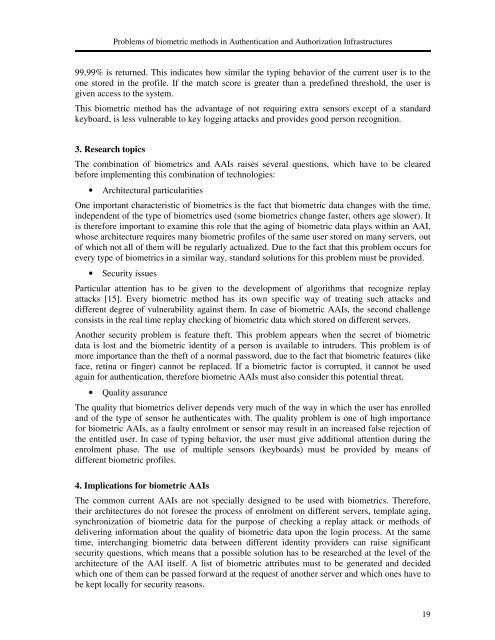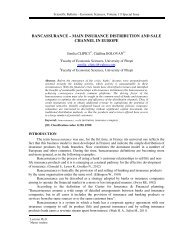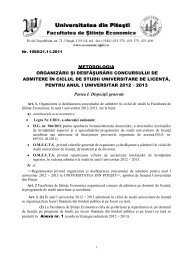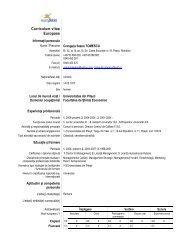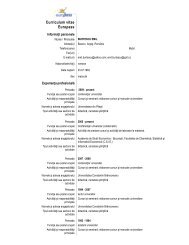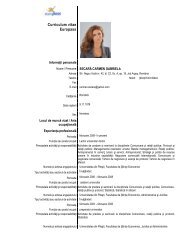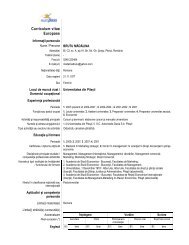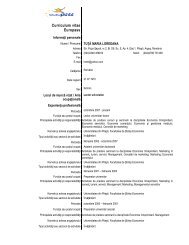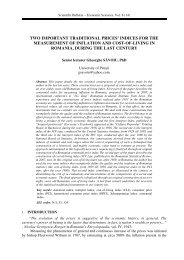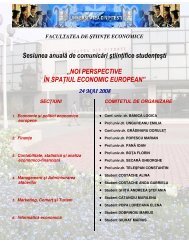buletin Åtiin ific - Facultatea de Stiinte Economice - Universitatea din ...
buletin Åtiin ific - Facultatea de Stiinte Economice - Universitatea din ...
buletin Åtiin ific - Facultatea de Stiinte Economice - Universitatea din ...
- No tags were found...
You also want an ePaper? Increase the reach of your titles
YUMPU automatically turns print PDFs into web optimized ePapers that Google loves.
Problems of biometric methods in Authentication and Authorization Infrastructures99,99% is returned. This indicates how similar the typing behavior of the current user is to theone stored in the profile. If the match score is greater than a pre<strong>de</strong>fined threshold, the user isgiven access to the system.This biometric method has the advantage of not requiring extra sensors except of a standardkeyboard, is less vulnerable to key logging attacks and provi<strong>de</strong>s good person recognition.3. Research topicsThe combination of biometrics and AAIs raises several questions, which have to be clearedbefore implementing this combination of technologies:• Architectural particularitiesOne important characteristic of biometrics is the fact that biometric data changes with the time,in<strong>de</strong>pen<strong>de</strong>nt of the type of biometrics used (some biometrics change faster, others age slower). Itis therefore important to examine this role that the aging of biometric data plays within an AAI,whose architecture requires many biometric profiles of the same user stored on many servers, outof which not all of them will be regularly actualized. Due to the fact that this problem occurs forevery type of biometrics in a similar way, standard solutions for this problem must be provi<strong>de</strong>d.• Security issuesParticular attention has to be given to the <strong>de</strong>velopment of algorithms that recognize replayattacks [15]. Every biometric method has its own spec<strong>ific</strong> way of treating such attacks anddifferent <strong>de</strong>gree of vulnerability against them. In case of biometric AAIs, the second challengeconsists in the real time replay checking of biometric data which stored on different servers.Another security problem is feature theft. This problem appears when the secret of biometricdata is lost and the biometric i<strong>de</strong>ntity of a person is available to intru<strong>de</strong>rs. This problem is ofmore importance than the theft of a normal password, due to the fact that biometric features (likeface, retina or finger) cannot be replaced. If a biometric factor is corrupted, it cannot be usedagain for authentication, therefore biometric AAIs must also consi<strong>de</strong>r this potential threat.• Quality assuranceThe quality that biometrics <strong>de</strong>liver <strong>de</strong>pends very much of the way in which the user has enrolledand of the type of sensor he authenticates with. The quality problem is one of high importancefor biometric AAIs, as a faulty enrolment or sensor may result in an increased false rejection ofthe entitled user. In case of typing behavior, the user must give additional attention during theenrolment phase. The use of multiple sensors (keyboards) must be provi<strong>de</strong>d by means ofdifferent biometric profiles.4. Implications for biometric AAIsThe common current AAIs are not specially <strong>de</strong>signed to be used with biometrics. Therefore,their architectures do not foresee the process of enrolment on different servers, template aging,synchronization of biometric data for the purpose of checking a replay attack or methods of<strong>de</strong>livering information about the quality of biometric data upon the login process. At the sametime, interchanging biometric data between different i<strong>de</strong>ntity provi<strong>de</strong>rs can raise sign<strong>ific</strong>antsecurity questions, which means that a possible solution has to be researched at the level of thearchitecture of the AAI itself. A list of biometric attributes must to be generated and <strong>de</strong>ci<strong>de</strong>dwhich one of them can be passed forward at the request of another server and which ones have tobe kept locally for security reasons.19


